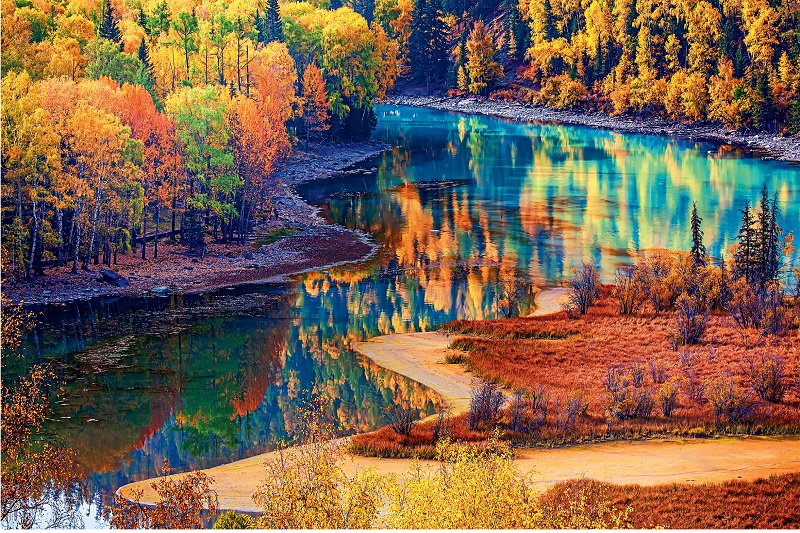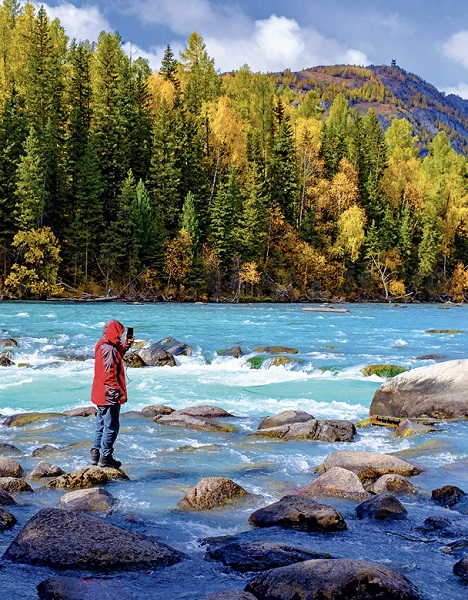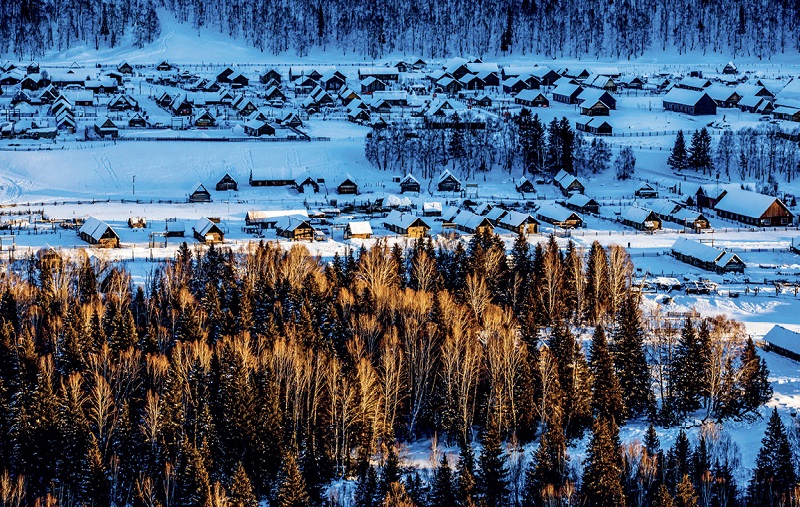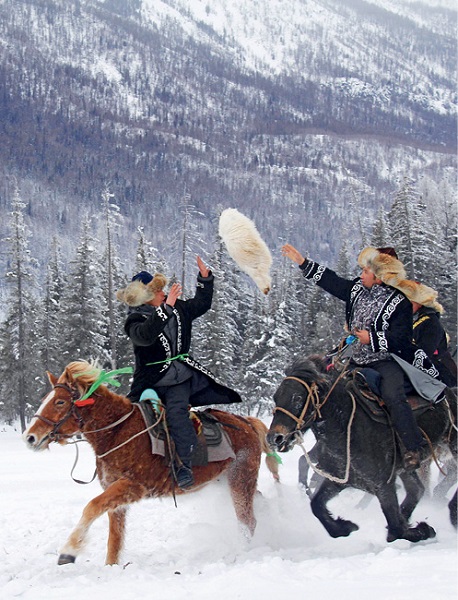
Kanas lies in the Altai Mountains in northern Xinjiang, 150 kilometers from Burqin County, which is bordered by Kazakhstan, Russia, and Mongolia. With a span of 10,030 square kilometers, it is the largest 5A national scenic area in China. It is also a national natural heritage site — and a national low-carbon tourism experimental area — which contains Kanas Lake National Geo Park and Baihaba National Forest Park.
Kanas means “a land of beauty and mystery” in Mongolian. Kanas is usually referred to as a large scenic area, featuring three major scenic areas: Kanas Scenic Area, Hemu Scenic Area, and Baihaba Scenic Area.

Tourists walking on rocks in Kanas Lake on September 24, 2017.
Kanas Scenic Area
In the Kanas Scenic Area, the most popular spots are the Kanas Lake, the Guanyu Pavilion (Fish Watching Platform), and three bays: the Shenxian Bay (Fairy Bay), Yueliang Bay (Moon Bay), and Wolong Bay (Crouching Dragon Bay).
The Kanas Lake is a must-see attraction in the Kanas Scenic Area, which is a masterpiece of the fourth glacial period from about 200,000 years ago and the deepest inland alpine lake in China. At an elevation of 1,374 meters, it is shaped like a crescent moon and has a maximum width of about 2,600 meters and a maximum depth of 188 meters, covering an area of about 45 square kilometers.
The wonder of the Kanas Lake is its changing colors with the change of seasons and weather; sometimes blue, sometimes turquoise, sometimes green, and sometimes grayish. The reflection of the sky in the water is dark blue on a sunny day, and it is dark green when the sky is overcast and the trees on the bank turn green. In August and September, the color transforms to a “Tiffany blue tinted with milky white” as the upstream waters flow in.
Since some claimed that they had discovered and photographed a “giant lake monster” in the Kanas Lake in 1980, Kanas Lake monster has remained a well-known, unsolved “mystery.” The search for this lake monster has never stopped, and yet there is still no affirmative answer to these claims. Many scholars and researchers have put forward speculations about the lake monster, and three of the most plausible ones are: first, it is a giant red fish, called Siberian taimen. This fish seldom surfaces and only lives in cold clear water with a water temperature below 20 degrees Celsius all year round. The second explanation is that it is a new species that has not yet been catalogued and studied. Third, it is a huge reptilian creature that survived from very ancient times.
Sightseeing cruises are available at the lake where, from up close, visitors can enjoy a stunning view of the lake which lies in the arms of the mountains, as well as the secluded scenery of the canyon. For those who want some exercise, they can stroll along the wooden walkway in the shade of dense trees on both sides. After a close-up visit of the lake, visitors can also go up to the Guanyu Pavilion to get a panoramic view of the Kanas Lake. To get to the Guanyu Pavilion, a shuttle bus ride is recommended, which takes visitors halfway up the mountain and there 1,068 steps have to be ascended before reaching the top. The pavilion is built at an elevation of 2,030 meters above sea level and is more than 600 meters above the Kanas Lake, making it the best position to observe the “lake monster.”
As for the bay visit, there is a shuttle bus which stops at each bay, but most visitors take it to the Shenxian Bay first, an ideal spot to take pictures. For those who can get up early in the morning, they can enter the scenic area early in the morning and experience the famous morning fog enshrouding them. The river valley here has a gentle slope, forming large swamps and meadows on the riverbank. Here, the mountain, river, and trees are usually shrouded with clouds and fog, appearing like a realm conjured from fantasy. After enjoying the beautiful scenery of the Shenxian Bay, visitors can go back to take the bus and go on to the Yueliang Bay.
The stop of Yueliang Bay is halfway up the mountain. Standing on the observation deck, tourists can relish panoramic views of the delicate curve of the Bay, which is shaped like a carefully placed blue-green ribbon. The river flows quietly through the narrowing canyon. From the observation deck, tourists get a wide view of the bay, and can also walk down the trail for a closer view. Unlike the view from a distance — rocks lying at the bottom, withered branches which have fallen into the water, and swinging aquatic plants can be seen — all giving the lake more varied colors and a more enchanting look when viewed up close.
After that, instead of taking the shuttle bus, visitors can opt to take a trek along the trail starting from the Shenxian Bay to the Wolong Bay. This section of the trail is less than 3,000-meter long but boasts breathtaking views of the valley, making it ideal for hiking. Throughout the route, the Kanas River is on the right-hand side. It is a mentally refreshing and healing journey for tourists to walk in the shade of trees, listening to the bubbling river and chirping birds, allowing themselves to have an immersion experience in nature. Visitors who have the stamina should definitely not miss out on this trekking route which takes around 50 minutes to complete. There is a sandbar with lush vegetation in the center of the river bay looking much like a dinosaur lying still in the water, it is hence named Wolong Bay.

On January 18, 2018, Hemu Village in Xinjiang is covered in snow and ice.
Hemu Village
The village of Hemu is a pleasant paradise nestled in the mountains of Kanas. It takes only one hour to drive from Kanas scenic area to Hemu which is about 35 kilometers away.
The village of Hemu is one of the only three remaining Tuvan villages and also the largest and most remote one. In China, the Tuvan people belong to the Mongolian ethnic group. Some people call them “a primitive tribe wandering in the depths of Xinjiang.” Since the Tuvan people have only maintained an oral form of their language without a writing system, information about their history and their ancestors can only be handed down orally from generation to generation, which adds more mystery to the history of the “Tuvan people.” Today, Tuvan people live in Russia, Mongolia, and China, and the group of Tuva staying in Kanas have lived here for hundreds of years.
The village of Hemu is nestled in a quiet valley in Kanas, dotted with Tuvan wooden huts and livestock pens. A ravine meanders through the village. Wisps of vapor form a winding white ribbon over the trees, floating between the village and the mountains. The river, wooden houses, rising smoke from cooking, serene birch forest, and people working and relaxing in the meadow form a scene of charming rural life. Visitors are free to wander around and experience the unique vibe of the ancient village.
The morning fog can be seen here almost every day, making it an iconic feature of Hemu. However, the intensity of the fog varies depending on the weather. It is suitable to go to Hemu in any season as it presents myriad scenery for every season, each with its own distinct charm. For example, in spring and summer, the grasslands are lush green and flowers are in full bloom; in autumn, the trees turn yellow and the landscape becomes golden hued; in winter, everything is covered with snow, and it looks like a frozen wonderland.

Villagers are playing a traditional ethnic sport of lamb grabbing on horseback.
Baihaba Village
Baihaba Village is located on the border between China and Kazakhstan, only 1.5 kilometers from a town in Kazakhstan which is easily accessible owing to a road connecting the two counties. Like Hemu, Baihaba is also a Tuvan village. On the other hand, however, unlike the quaint village of Hemu, Baihaba is more like an isolated world in a pristine natural environment and is known as one of the eight most beautiful towns in China.
On the flat meadows in the mountains and forests are small wooden houses where flocks of goats can be seen in the vicinity of the village. There are two spots to overlook Baihaba — the new village and the back of the old village. Visitors can ride horses through the birch jungle to the top of the mountain and get a glimpse of Kazakhstan. The view of Baihaba in winter is even more fantastic. In mid-October, the winter season begins and the whole village is already covered with snow. It is particularly romantic to see the snow-covered cottages from above, like walking into a fairy tale world of snow. Tourists can also see the villagers patrolling the area on horses, resembling an era long gone by.
In Kanas, the snowy mountains, glaciers, forests, grasslands, and meadows are beautiful, robust, and mysterious. Of course, in addition to the natural scenery, there is also the allure of the unique Tuvan culture. Nowadays, hostels constructed from natural materials such as wood are also available in Baihaba and Hemu villages, allowing visitors to stay and immerse themselves in the local scenery and life.